Sarah Penn, MD at Outstanding Branding, has written a thought provoking article from her experience as a woman leading a successful business, and it is certainly worth a read:
“Women make more successful entrepreneurs, depending of course on how you define success.
According to an article in the Metro newspaper this week, research shows that only 11% of female entrepreneurs’ new ventures have failed, compared with 17% of men’s.
Great news, for those championing equality and promoting female business skills might think. Women can outperform men in the business world; thrive in a very traditionally ‘male’ high risk environment; and now we have the statistics to prove it.
But as so often, statistics are only half the story, and headlines, like mine, can be misleading.
An article last year in the New York Times, quoting a study by Babson College into graduates of Goldman Sachs’ 10,000 Small Businesses programme, showed that the female entrepreneurs joining the programme were paying themselves, on average, 80% of what the male entrepreneurs were paying themselves.
There are of course various theories that could explain this: women’s salary expectations are lower, based on their experience in their previously paid work. Women tend to be more risk averse than men, preferring to take less money out of the business until they are more confident it’s sustainable to do so. Or perhaps that women tend to start businesses in sectors which simply generate less cash.
My personal thoughts? A combination of the three. There are after all plenty of studies confirming the very real existence of the gender pay gap – I know many swear blind it doesn’t, can’t exist, but I don’t believe it can be denied completely.
As for women being more risk-averse than men, my personal experience of running a business with a male business partner certainly gives one true-life example of this. My business partner has vision, drive, and is not afraid to invest everything we have to deliver as close to perfection as possible to our clients, staff and supply chain. I am more inclined to see the detail, the downside, the potential disaster; this I might add doesn’t necessarily make me happy, however it does mean that we don’t embark on any of his more ambitious plans, without being sure we can make them work.
And looking at business sectors – as a female MD, I am often invited to attend Women in Business events, to share knowledge, experiences and network. I’m always surprised and, yes I’ll admit, a little disappointed to find that in general I’m the only woman there with a business growth plan, a management team, employees; almost everyone else is a one-woman-band, operating in the ‘soft skills’ sector, offering services like training, personal coaching, PR or counselling. Very few seem to have had the desire to push on and build a team and a business beyond their initial skillset and offering.
And in fact perhaps this is the truth of it; it’s growth of a business that brings the biggest chance of failure – finding new clients while keeping existing clients happy; recruiting, building, managing a team; working to a strategic plan; finding the time to even create a strategic plan in the first place; and of course every growing company’s biggest challenge, managing cash flow.
So perhaps, because they tend for a range of reasons not to push forward outside this safe zone, and into high growth, high risk areas, female entrepreneurs’ businesses are more successful.
Depending again on how you define success.”
Published on: August 21st, 2015





